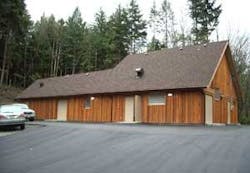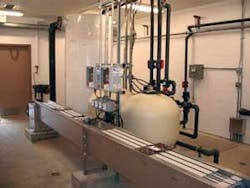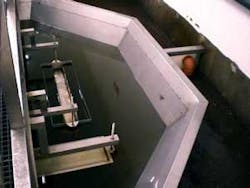Decentralized WWTP Meets Environmentally Sensitive Discharge Limits
With the technological advances of small plant performance and reliability, decentralized wastewater treatment plants have become eminently feasible. Smaller local treatment plants in place of a large central facility allow for considerable economical advantages including the reduction of costly collection infrastructure as well as providing the opportunity for smaller incremental-as-needed expansion phasing. Significant environmental and practical advantages also exist, including the possibility of reclaimed water re-use or disposal even in an environmentally sensitive locality.
Early this decade, Indian & Northern Affairs Canada (INAC) was evaluating the construction of a wastewater treatment plant to serve the Snaw-naw-as First Nation village in Nanoose Bay in British Columbia. The plant was to initially serve the village itself but future expansions were anticipated including the village growth and the future commercial developments alongside the nearby highway. The treated effluent was to be discharged by an ocean outfall into the environmentally sensitive Nanoose Bay.
In 2002, INAC commissioned Chatwin Engineering and Novatec Consultants to prepare Expression of Interest (EOI) and later Request for Proposal (RFP) documents, and after the due evaluation process the project was in 2004 awarded to Knappett Construction Ltd of Victoria (General Contractor), and ECOfluid Systems Inc. (Treatment technology designer and provider).
The project award and the facility construction and operation included several innovative approaches, such as awarding the contract as a design/build/operate (DBO) contract, and a later inclusion of the development and implementation of the Band Members training to become certified operators in due time.
Design Criteria
The design criteria for the new plant came directly from the decentralized facility order book:
- Produce Class A effluent as stipulated by the Municipal Sewage Regulations (MSR), (BOD5, TSS and Total Nitrogen of respectively less than 10, 10 and 20 mg/l, ammonia nitrogen of less than 1 mg/l and fecal coliform of less than 14/100 ml.)
- Discharge the treated effluent into an environmentally sensitive water body.
- Allow for future incremental plant expansion. The initial capacity of 119 m3/d will be expanded in five future stages, each sized for an average day flow of approximately 132 m3/d to an ultimate future average day capacity of 775 m3/d. (In phases 4, 5 and 6, a mirror image plant is to be built).
- Build a decentralized treatment facility having a minimal visual, odor and noise impact on the neighborhood.
- Design an operator friendly plant keeping in mind that the plant will be for the most part operated by the Band member operator trainees.
- Design a SCADA controlled plant that can be remotely monitored.
- Develop and implement an operators’ training program for the Snawnaw- as Band members, with the ultimate aspiration to attain wastewater treatment plant operators’ certificate as per the requirements of the Environmental Operators Certification Program.
null
The Design
As mandated, the plant was designed to be simple and easy to operate. The influent is pumped into an IPEC drum screen with 6 mm openings and provided with a sealed, continuous bagging system. Screened influent drops into an equalization tank provided with a set of duplex equalization pumps which are controlled by float switches and timers.
The screened influent is then pumped through a flow splitter box into the anoxic compartments of two upflow sludge blanket filter (USBF) bioreactors. Influent and recycled activated sludge mixed liquor flows to the aerobic compartment and the sludge and the treated water are eventually separated by the USBF.
From the sludge blanket filter the treated effluent flows to the filter feed tank, from which, controlled by flow switches, it is pumped through sand filters to the ultraviolet disinfection system overflow feed tank (which also serves as a reservoir for the sand filter backwash water). After flowing through the open channel Trojan UV disinfection unit, the effluent is discharged via ocean outfall into Nanoose Bay.
Waste sludge is thickened in the ECOfluid STP pre-thickeners to approximately 2% dry solids, and controlled by sludge pre-thickener pump timers, waste sludge is transferred to the sludge holding tank before being periodically hauled away for disposal.
The entire process is automatic and is SCADA monitored and controlled. Very little direct input from operators is required.
The design underwent extensive and drawn-out reviews by INAC and its consultants, and the construction finally commenced in April 2005.
The Plant
The first phase of the plant was built over the next six months. To keep with the design criteria, the entire plant was installed within a building esthetically blending with the surrounding environment.
The small footprint of the bioreactors allowed them to be installed below ground and within the building. Noise from the plant was reduced by the fact that the USBF’s self-regulating hydraulics result in minimal motorized noise-emanating equipment, and by the blower enclosure noise abatement design. In fact, the noise from the nearby highway is often higher than that emanating from the plant.
USBF bioreactors operate odor free. The only other sources of odor, such as the screen room and the equalization tank gas phase, are piped into the suction of an air fan which passes the collected gas through a biofilter bed.
Phase 1 of the plant started to receive wastewater on October 20, 2005. The first sampling and analysis were performed within two weeks of the plant start-up and the data were well within the design parameters.
Plant Performance
In the last three years the plant performance has been consistently within the Class A design parameters. A table with this article summarizes annual averages of monthly sampling and analysis.
Prior to sampling of the influent BOD, the operators and the designers were baffled by the elevated Total Nitrogen, which, while still within the design criteria, hovered higher than the 10 mg/l typically expected of the USBF plants.
The subsequent analysis of the influent BOD confirmed the initial suspicion; the consistently low influent BOD did not provide sufficient donor carbon necessary for denitrification. It is interesting to observe that the one year the influent BOD was higher (2006), resulted in much better denitrification and TN was reduced to an average of 12.5 mg/l. Although the plant still performs within the design criteria, the addition of supplemental carbon on a trial basis will be implemented.
To compound the denitrification process challenge, it was recently discovered through the construction photos that a fine air bubble diffuser was by error installed within the anoxic compartment instead of a coarse air bubbler intended for mixing. The situation will be corrected in early spring of 2009.
Addition of supplemental carbon, and replacement of the fine air diffuser in the anoxic compartment will no doubt bring the Total Nitrogen levels closer to, or below the USBF customary 10 mg/l.
The plant absolute power consumption is approximately 250 kWh/day. The specific power consumption (kWh/m3 or kWh/kg BOD) will reach its optimum when the plant capacity loading will increase.
Operator Training
The development and the implementation of the Band Members operating training program were the first for INAC and ECOfluid. The program’s goal was to have two band members attain the wastewater treatment plant operators’ certificate as per the requirements of the EOCP. Two trainees were selected by the band and the training started even before construction was completed.
Based on the Sacramento State Office of Water Programs (OWP), and other sources, the training curriculum and methodology were developed entirely by ECOfluid, and included both classroom lectures and hands-on, practical education and training.
To-date, both original trainees are still maintaining the day-to-day operations of the plant. They have shown a passion for the job and have embraced the steep learning curve. Daily reports are submitted to the ECOfluid chief operator, who visits the plant periodically but who in any case is never more than a few hours away, outlining operating parameters and issues that need to be addressed.
Both trainees are ahead of the scheduled training program. They have accumulated over 3,000 hours of plant operating experience, and they have both very successfully passed Sacramento State OWP Level 1 examinations.
Their experience and level of competence makes them very ready to write the EOCP Level 1 examination.
Conclusion
The Snaw-naw-as decentralized wastewater treatment plant is continuing to successfully fulfill all of its design requirements, functions and objectives. In the spirit of a good decentralized facility, the plant is completely inconspicuous. It is visually non-offensive, and noise- and odor-free.
Most importantly, the plant produces Class A reclaimed water that can be discharged locally into the sensitive Nanoose Bay without any environmental consequences. WW





